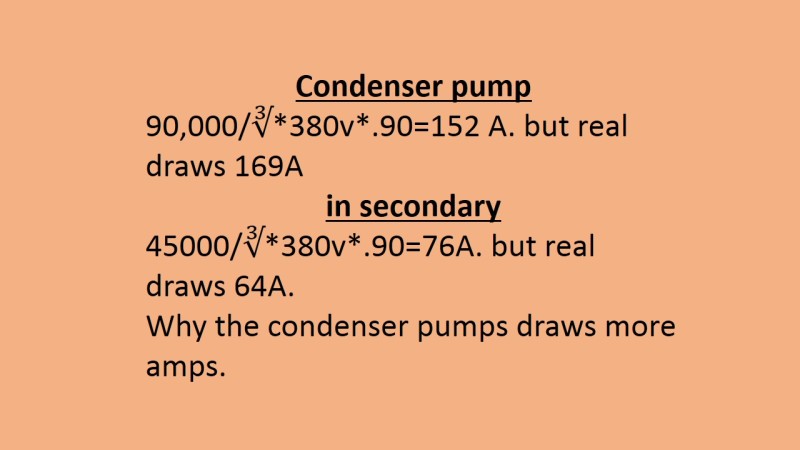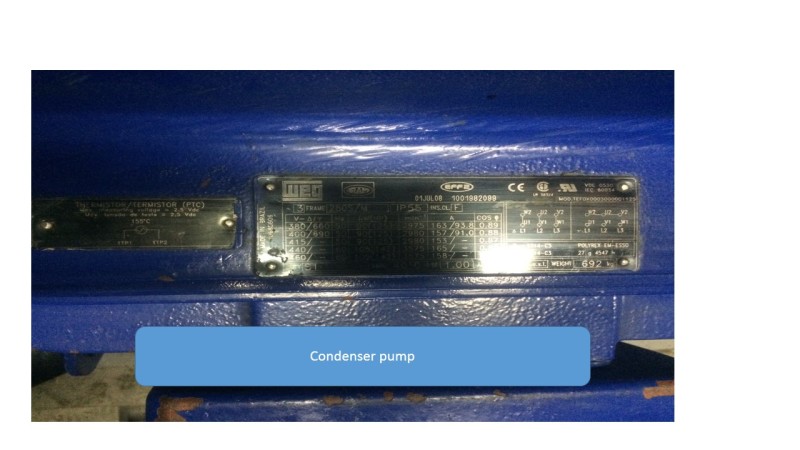Navigation
Install the app
How to install the app on iOS
Follow along with the video below to see how to install our site as a web app on your home screen.
Note: This feature may not be available in some browsers.
More options
Style variation
-
Congratulations cowski on being selected by the Eng-Tips community for having the most helpful posts in the forums last week. Way to Go!
You are using an out of date browser. It may not display this or other websites correctly.
You should upgrade or use an alternative browser.
You should upgrade or use an alternative browser.
pump draws more ampere
- Thread starter moideen
- Start date
- Status
- Not open for further replies.
LittleInch
Petroleum
Many possibilities.
Diffe re b t voltage at the pump than the nominal voltage.
Actual motor efficiency different than 0.9.
You haven't included power factor.
Motor rating and power used are not the same thing. Where does 90 and 45 come from? If it's not the shaft power used then it's not the right figure.
Remember - More details = better answers
Also: If you get a response it's polite to respond to it.
Diffe re b t voltage at the pump than the nominal voltage.
Actual motor efficiency different than 0.9.
You haven't included power factor.
Motor rating and power used are not the same thing. Where does 90 and 45 come from? If it's not the shaft power used then it's not the right figure.
Remember - More details = better answers
Also: If you get a response it's polite to respond to it.
The first obvious thing is that 90 kw and 45 kw is motor output whereas the current is input. Who knows whether the 0.9 is supposed to be efficiency or power factor but either way there is a factor missing.
Regards
Ashtree
"Any water can be made potable if you filter it through enough money"
Regards
Ashtree
"Any water can be made potable if you filter it through enough money"
- Thread starter
- #4
Hi moideen.
Regardless of any equations or other info, the name plate maximum current is the number you must follow. That is the actual current running in your motor's windings. Exceeding it means you're over working the motor and it is going to be running hotter and at a less forgiving operating point.
Your condensate pump should not be drawing more than 163A, but it is drawing 169A. It is good that you are investigating it!
Things that can cause this:
1) The voltage being supplied is below the desired value. For every bit lower the voltage is below the 380V on the plate, more current will be required by the motor. Unfortunately more current automatically means more heat in the motor.
What is the actual voltage between all phases? (Exercise caution measuring it!)
2) Voltage very much higher than the nameplate will also cause higher current as the motor magnetics will be saturating.
3) The frequency being higher than 50Hz would also lead to higher current because the motor would be trying to spin faster and pump more. This is likely not the issue unless your power supply is poorly controlled. It would be a little more likely if you're on a local generator that is perhaps running a bit too fast.
4) The pump is loaded more than it should be. This is possible if, in any way, more flow is occurring than designed for. This would be because there is less restriction in the system then there should be. Perhaps a throttling valve to limit the flow to below overloading the motor has been opened fully in an attempt to 'get more performance' and instead will just lead to a shorter motor life. Other possibilities might be more demand than usual in the condenser circuit, again allowing more than expected flow. Do you have any flow gauges or any way to determine the flow? Folks in here can help you if you know the flow and have a pump-plate picture that is readable. (Your motor plate pictures have bad glare that makes them just barely readable.)
Keith Cress
kcress -
Regardless of any equations or other info, the name plate maximum current is the number you must follow. That is the actual current running in your motor's windings. Exceeding it means you're over working the motor and it is going to be running hotter and at a less forgiving operating point.
Your condensate pump should not be drawing more than 163A, but it is drawing 169A. It is good that you are investigating it!
Things that can cause this:
1) The voltage being supplied is below the desired value. For every bit lower the voltage is below the 380V on the plate, more current will be required by the motor. Unfortunately more current automatically means more heat in the motor.
What is the actual voltage between all phases? (Exercise caution measuring it!)
2) Voltage very much higher than the nameplate will also cause higher current as the motor magnetics will be saturating.
3) The frequency being higher than 50Hz would also lead to higher current because the motor would be trying to spin faster and pump more. This is likely not the issue unless your power supply is poorly controlled. It would be a little more likely if you're on a local generator that is perhaps running a bit too fast.
4) The pump is loaded more than it should be. This is possible if, in any way, more flow is occurring than designed for. This would be because there is less restriction in the system then there should be. Perhaps a throttling valve to limit the flow to below overloading the motor has been opened fully in an attempt to 'get more performance' and instead will just lead to a shorter motor life. Other possibilities might be more demand than usual in the condenser circuit, again allowing more than expected flow. Do you have any flow gauges or any way to determine the flow? Folks in here can help you if you know the flow and have a pump-plate picture that is readable. (Your motor plate pictures have bad glare that makes them just barely readable.)
Keith Cress
kcress -
LittleInch
Petroleum
From the name plate you can see that the overall motor efficiency is worse than 0.9. You calculated 152 amps but nameplate says 163.
So you're running your big motor at 104%. Not great but in reality will survive for a while but you will reduce operating life and it may trip on excess amps or high temperature.
Remember - More details = better answers
Also: If you get a response it's polite to respond to it.
So you're running your big motor at 104%. Not great but in reality will survive for a while but you will reduce operating life and it may trip on excess amps or high temperature.
Remember - More details = better answers
Also: If you get a response it's polite to respond to it.
You asked why and have given what you have assumed is the electrical data, how about pump data like the pump curve, operating design point and actual pump performance. For me any pump over amping(assuming voltage is correct) would indicate over capacity from the pump.
Without pump data it's all guess work.
It is a capital mistake to theorise before one has data. Insensibly one begins to twist facts to suit theories, instead of theories to suit facts. (Sherlock Holmes - A Scandal in Bohemia.)
Without pump data it's all guess work.
It is a capital mistake to theorise before one has data. Insensibly one begins to twist facts to suit theories, instead of theories to suit facts. (Sherlock Holmes - A Scandal in Bohemia.)
LittleInch
Petroleum
I still think all stems from the incorrect but common thinking that a 45kW fixed speed motor provides 45kW of output power regardless of what the pump is doing.
It doesn't.
Therefore look at the pump duty first before looking at alk the other things mentioned above.
Remember - More details = better answers
Also: If you get a response it's polite to respond to it.
It doesn't.
Therefore look at the pump duty first before looking at alk the other things mentioned above.
Remember - More details = better answers
Also: If you get a response it's polite to respond to it.
Its pointing more and more that your pulling too much power from the pump - pump is working towards end of curve so well worth checking actual flow and pressure being produced against the performance curve, that then will indicate if your pulling too much power and in turn pulling a high current.
Its a common problem when running at end of curve...
Ash Fenn
Its a common problem when running at end of curve...
Ash Fenn
- Thread starter
- #11
itsmoked :-thanks, (Voltage very much higher than the nameplate will also cause higher current as the motor magnetic will be saturating), could not understand. what you mean magnetic saturating, could not understand.no chance for frequency change being no vfd for this pump.
as design, 960 gpm is the flow rate, but i will check the actual flow.
as design, 960 gpm is the flow rate, but i will check the actual flow.
- Thread starter
- #12
LittleInch:I heard there were some issues in commissioning time on this motor. I do not know more details. Might be adjusted the flow rate regardless of design flow rate. Need to check flow rate of all pumps. I suspect something happened on this plant at beginning, because it total plant energy consumption is very high.
moideen. A motor is a magnetic based device. Just like a wire is designed for a certain maximum current a motor's magnetic iron circuit is designed for a maximum magnetic flux. As the voltage goes up the magnetic flux goes up. At a certain point no more flux can be accommodated and over-current occurs and rapidly increases.
Keith Cress
kcress -
Keith Cress
kcress -
- Thread starter
- #14
- Status
- Not open for further replies.
Similar threads
- Replies
- 18
- Views
- 4K



